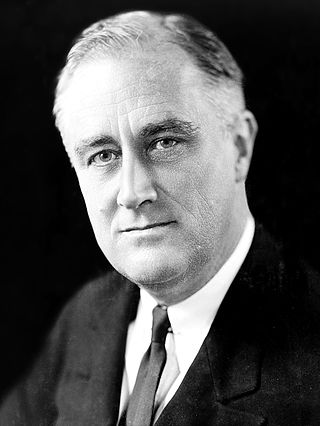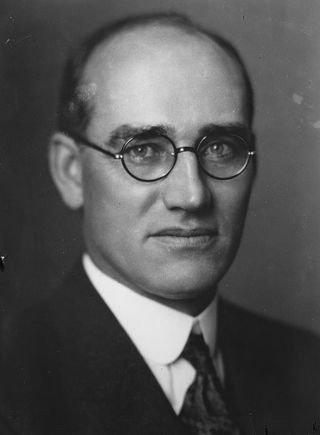
The 1932 United States presidential election was the 37th quadrennial presidential election, held on Tuesday, November 8, 1932. The election took place against the backdrop of the Great Depression. The incumbent Republican President Herbert Hoover was defeated in a landslide by Democrat Franklin D. Roosevelt, the governor of New York and the vice presidential nominee of the 1920 presidential election. Roosevelt was the first Democrat in 80 years to simultaneously win an outright majority of the electoral college and popular vote, a feat last accomplished by Franklin Pierce in 1852, as well as the first Democrat in 56 years to win a majority of the popular vote, which was last done by Samuel J. Tilden in 1876. Roosevelt was the last sitting governor to be elected president until Bill Clinton in 1992. Hoover became the first incumbent president to lose an election to another term since William Howard Taft in 1912, and the last to do so until Gerald Ford lost 44 years later. The election marked the effective end of the Fourth Party System, which had been dominated by Republicans. It was the first time since 1916 that a Democrat was elected president.

The 1930 United States Senate elections occurred in the middle of Republican President Herbert Hoover's term. The 32 seats of Class 2 were contested in regular elections, and special elections were held to fill vacancies. With the Great Depression beginning to take hold, Republican incumbents became unpopular, and Democrats picked up a net of eight seats, erasing the Republican gains from the previous election cycle, however, Republicans retained control of the chamber. This was the first of four consecutive Senate elections during the Depression in which Democrats made enormous gains, achieving a cumulative pick-up of 34 seats.

Wilber Marion Brucker was an American Republican politician. Born in Saginaw, Michigan, he served as the 32nd governor of Michigan from 1931 to 1933 and as the United States Secretary of the Army between July 21, 1955, and January 19, 1961.

William Alfred Comstock was an American politician who served as the 33rd governor of Michigan.

The 1986 United States Senate election in California took place on November 4, 1986. Incumbent Democratic U.S. Senator Alan Cranston narrowly won re-election to a fourth and final term over Republican U.S. Congressman Ed Zschau. This was the last time where both major party nominees for the Class 3 Senate seat in California were men until 2022.

The 2014 United States House of Representatives elections in Virginia were held on Tuesday, November 4, 2014, to elect the 11 members from the state of Virginia to the United States House of Representatives, one from each of the state's 11 congressional districts. On the same day, elections took place for other federal and state offices, including an election to the United States Senate. Primary elections, in which party nominees were chosen, were held on June 10, 2014.

Paul Warren Voorhies was a Michigan lawyer who served as Wayne County Prosecutor and Michigan Attorney General.

The 2018 United States House of Representatives elections in Virginia were held on November 6, 2018, to elect the 11 U.S. representatives from the state of Virginia, one from each of the state's 11 congressional districts. The elections coincided with other states' elections to the House of Representatives, elections to the United States Senate and various state and local elections. Primary elections took place on June 12.

The 1936 United States Senate election in Michigan was held on November 3, 1936. Incumbent Republican U.S. Senator James J. Couzens ran for re-election to a third term in office, but was defeated in the Republican primary by Governor Wilber Brucker. Brucker was defeated in the general election by Democratic U.S. Representative Prentiss M. Brown, becoming the first Democrat to win this seat since 1853.

The 1934 United States Senate election in Wisconsin was held on November 6, 1934.
This article covers events from the year 1930 in Michigan.

Virginia's 10th congressional district election was one of the highest-profile United States House of Representatives elections of 2018, and the most competitive in Virginia. Republican incumbent Barbara Comstock lost re-election to a third term to Democrat Jennifer Wexton, a lawyer and State Senator representing Loudoun County.

The 1864 Michigan gubernatorial election was held on November 8, 1864. Republican nominee Henry H. Crapo defeated Democratic nominee William M. Fenton with 55.15% of the vote.

The 1870 Michigan gubernatorial election was held on November 1, 1870. Incumbent Republican Henry P. Baldwin defeated Democratic nominee Charles C. Comstock with 53.71% of the vote.

The 1904 Michigan gubernatorial election was held on November 1, 1904. Republican nominee Fred M. Warner defeated Democratic candidate Woodbridge N. Ferris with 54.09% of the vote.

The 1926 Michigan gubernatorial election was held on November 2, 1926. Republican nominee Fred W. Green defeated Democratic nominee William Comstock with 63.35% of the vote.

The 1928 Michigan gubernatorial election was held on November 6, 1928. Incumbent Republican Fred W. Green defeated Democratic nominee William Comstock with 69.94% of the vote.

The 1932 Michigan gubernatorial election was held on November 8, 1932. Democratic nominee William Comstock defeated incumbent Republican Wilber M. Brucker with 54.92% of the vote.

The 1916 United States Senate election in New York was held on November 7, 1916. Incumbent Democratic Senator James O'Gorman chose not to seek re-election. Republican William M. Calder was elected to a succeed O'Gorman, defeating Democrat William F. McCombs.

The 1932 Wisconsin gubernatorial election was held on November 8, 1932. Incumbent Republican Governor Philip La Follette was defeated in the Republican primary, and in the midst of the Great Depression and nationwide voter dissatisfaction with the Republican Party, Democratic nominee Albert G. Schmedeman defeated Republican nominee Walter J. Kohler Sr. and Socialist nominee Frank Metcalfe with 52.48% of the vote. Schmedeman became the first Democrat to win a gubernatorial election in Wisconsin since George Wilbur Peck in 1892. 2 years later, in 1934, La Follette would run for governor again and defeated Schmedeman, this time running with the Progressive Party.





















